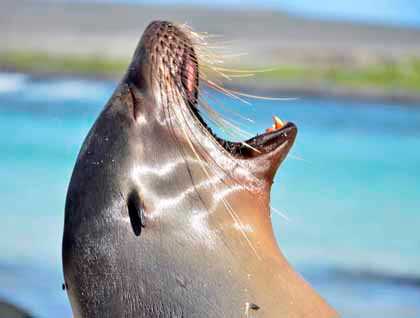It is our first full day on the islands, and today we had amazing experiences of discovery and exploration. We spent our day on the southeastern island of Española, formerly known as Hood Island. In the morning we visited Gardner Bay, where many options were offered to our guests, including exploring the underwater with deep water snorkeling, kayaking along the shore, or strolling along a white beach among dozens of resting sea lions. Before jumping into the blue ocean for snorkeling, we spotted a school of bottlenose dolphins; there were many of them, and we decided to jump right into the deep waters to enjoy a few minutes of these magical marine mammals. Swimming with dolphins in the wild is a not something that happens every day, and we did it!
In the afternoon, we visited another part of the island, Punta Suarez, which is one of the richest wildlife locations in Galapagos. Right at the disembarkation point, we were greeted by many marine iguanas and by sea lions, some of them pups that were only few days old. Further along the trail we saw the unique and endemic species of mockingbird, lava lizards and doves, as well as three different species of Darwin finches. The trail took us inland, where there was a combination of native and endemic species of plants, all them grey and very dry, since we are at the end of the dry and cold season. While admiring these unique species, soon we arrived to the nesting site of the waved albatrosses, to find many young ones that were showing off their juvenile plumage and training to fly. Some adults were displaying their last courting rituals, which very often resume the next breeding season with the same partner. Every year the entire population of these birds arrive to Española Island by mid-March to start their breeding cycle, and leave the Island by the end of December or the beginning of January, when they go in front of the coasts of Chile and Peru to their feeding grounds. These magnificent birds display one of the most spectacular courtship rituals among sea birds, and today we were lucky enough to see few couples engaging in this ritual.
Waved albatrosses, Galapagos hawks, Nazca boobies and blue footed boobies were along the trail that took us to the famous blow-hole, and then further into the open plateau of the island where hundreds of these birds nest.
Without any doubt, Espanola is has some of the most diverse wildlife of any of these islands, making it a must-see for any visitor of the Galapagos.







